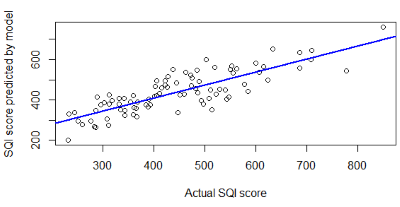Natural England asked us to answer a simple question: can wood-pasture and parkland quality be predicted?
The surprising answer is 'probably yes'.
We identified the Saproxylic Quality Index (SQI) as the best available measure of quality, as it was felt that a site's saproxylic (wood decay) beetle fauna would be a good surrogate of wider wood decay habitat quality, which is one of the most important elements of wood pasture and parkland. We combined available SQI scores with the wood-pasture and parkland inventory we had previously created for Natural England to create a sample dataset of 98 sites. We then analysed the sample data against other available data, including tree records from the Ancient Tree Hunt, geography, climate, designations and habitat networks using PostGIS and multiple regression analysis in the statistical package R. The models produced were refined to identify the model best able to predict wood-pasture and parkland quality.
Eleven site attributes were included in the final model for predicting SQI score. Sites in the south east and lowland sites tended to have higher scores, suggesting that warmer and less exposed sites were better for saproxylic beetles. Unsurprisingly sites with higher numbers and densities of veteran or ancient trees also tended to have higher scores, owing to the increased volume of wood decay habitat present.Sites that were in a landscape with other wood-pasture and parkland were also found to have higher SQI scores.
 The best model proved to be remarkably good at predicting the SQI score of the sample. It suggested that sites with a predicted score of 600 or more were likely to have an actual score of at least 400 - itself quite a high score. This suggests that if the model were applied to the wider wood-pasture and parkland inventory it could be used to predict SQI scores and identify sites that could be targeted for survey.
The best model proved to be remarkably good at predicting the SQI score of the sample. It suggested that sites with a predicted score of 600 or more were likely to have an actual score of at least 400 - itself quite a high score. This suggests that if the model were applied to the wider wood-pasture and parkland inventory it could be used to predict SQI scores and identify sites that could be targeted for survey.
However, this was a proof of concept study, so the model needs more work before we can conclusively state that wood-pasture and parkland quality can be predicted. This includes further refinements to identify attributes that help predict quality. It then needs to be tested to determine how well it predicts SQI scores for sites that were not part of the sample. We hope to be able to continue this work, as we believe the improved model could be very valuable for targeting entomological survey effort.
Further information from Crispin Flower.